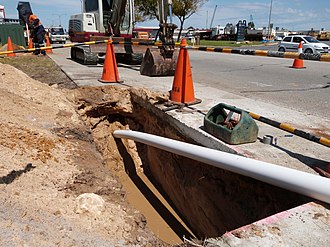Tubing material
Due to the placement of boreholes in the subsoil, soil is retrieved. This soil is used to evaluate and describe the soil profile and samples are taken from representative soil layers. Via finishing a borehole with a tube with one perforated part, it becomes possible to sample groundwater, determine the groundwater level, measure and sample floating- and pocket layers and/or measure the permeability of the soil.
Tubing material
A nylon filter stocking and a gravel deposit at the level of the filter can be used to improve the groundwater flow and prevent soil particles from flowing through the perforation. An appropriately sized and at the right height bentonite deposit above and possibly also below the filter must ensure that the only the groundwater is extracted from the desired soil layer.
After placing the tube for the collecting of groundwater, one must define it's material type which can be subdivided in the following categories.
Polyethylene (PE)
This description is used when it is not sure if the tube used has a high or low density. What is known, is that the tube used is a tube made from polyethylene.
Polyethylene High Density (HDPE)
This description is used when the tube that is used is made from high density polyethylene. The benefits of HDPE are its toughness and resistance to chemicals. Moreover its corrosion resistance and low weight also contributes to its widely usage. This type of tubing is very cost-effective and durable. Although HDPE pipe is often estimated to last 50 years, they are in fact more likely to have life expectancies of 100 years.[1]
Polyethylene Low Density (LDPE)
This description is used when the tube that is used is made from low density polyethylene. The benefits of LDPE are that it is very durable and reliable, it is light weighted and flexible, it is cost effective and resistant to corrosion and weather. Another great benefit of this method is that this material is not toxic for it's environment and the tubes are completely recyclable.
Polyethylene PVC
This description is used when the tube that is used is made from a mixture between polyethylene and pvc. It is not sure if the tube used has a high or low density. The benefits of PVC are that this material is less sensitive to thermal expansion. The downside of PVC is that it is not suitable for the storage or transport of water and is not so resistive against harsh weather. Moreover PVC can not easily be stored and transported to a location of interest. Due to the combination with polyethylene all the downsides of PVC are taken away by the characteristics of polyethylene. This combination leads to a strong thermal, chemical en physical resistive material which is ideal for the sampling of ground water.
Steel
This description is used when the tube that is used is made from steel and it is unknown which type of steel is used. Steel is very useful and easy to use in many environments. It is a reliable material that can be recycled and used in other places very easily. However, steel has one big downgrade. Steel can contaminate the soil and the water present within the tube which can result in wrong measurements.
Galvanized steel
This description is used when the tube that is used is made from galvanized steel. Due to its galvanization it will not intoxicate its surroundings as fast as a normal steel pipe. Galvanized steel is in general more ductile and easier to work with than stainless steel. Galvanized steel is the cheaper option in comparison to stainless steel.
For the most down to earth uses of steel on land, your most economical choice, in terms of both material and labor costs and life of the project, will be galvanized steel.
Stainless steel
This description is used when the tube that is used is made from stainless steel. Due to its stainless character it will not intoxicate its surroundings as fast as a normal steel pipe. Stainless steel is in general stronger and more corrosion-resistant than galvanized steel. Stainless steel is the more expensive option in comparison to galvanized steel.
There are situations in which you need to stay away from stainless steel. This product stands up to salt water, but it is quickly degraded after exposure to chlorinated water. You also need to avoid any design in which two stainless steel components generate friction against each other. They can weld themselves together.
